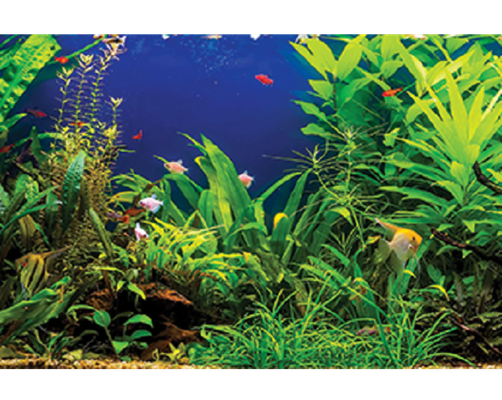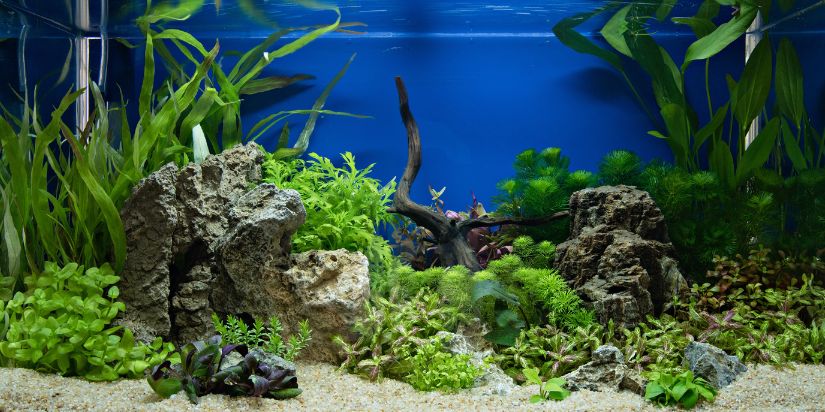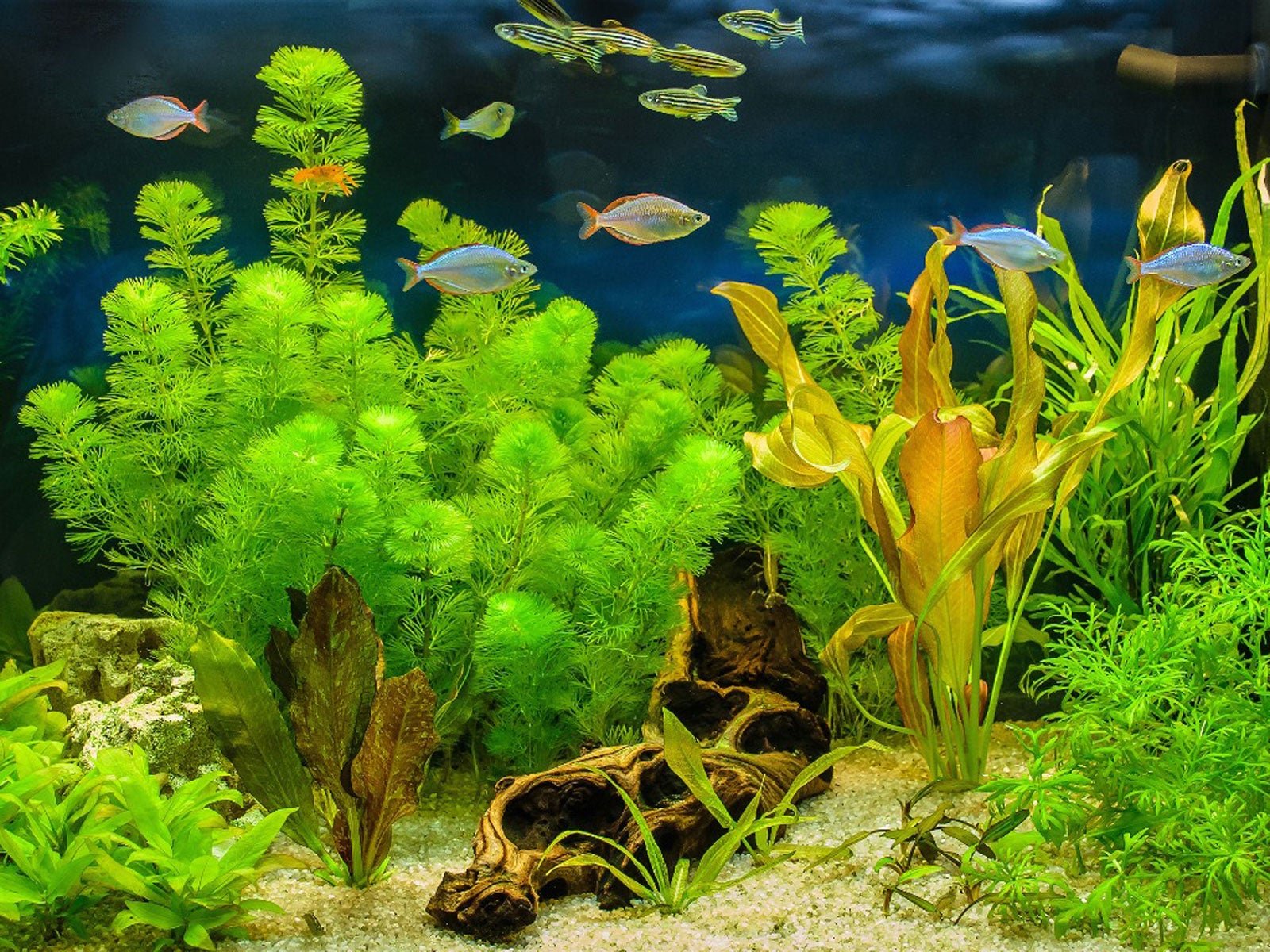Aqua plants bring life to aquariums. They add beauty and benefit fish.
Aquarium enthusiasts know the importance of creating a balanced ecosystem. Aqua plants help achieve this harmony. They act as natural filters, improving water quality. These plants also provide shelter and food for fish, making them essential for a healthy tank.
Besides their functional benefits, aqua plants enhance the visual appeal of aquariums, turning them into vibrant underwater landscapes. Selecting the right plants can transform your aquarium into a stunning display. Whether you’re a beginner or seasoned aquarist, understanding the role of aqua plants is crucial. This guide will explore different types of aqua plants and their benefits, helping you make informed choices for your aquarium setup. Dive into the world of aquatic greenery and enrich your aquarium experience.

Credit: www.aqueon.com
Introduction To Aquarium Plants
Creating a thriving aquarium requires more than just fish and water. Aquarium plants play a crucial role in maintaining a healthy aquatic environment. These plants provide shelter, improve water quality, and enhance the aesthetic appeal of your aquarium. They transform a simple tank into a vibrant underwater ecosystem.
Importance Of Aqua Plants
Aqua plants are not just decorative elements. They are vital for the ecosystem within your tank. They help stabilize the environment by absorbing harmful chemicals. They maintain the balance of oxygen and carbon dioxide. This ensures the survival of aquatic life.
Benefits For Aquatic Life
Plants provide a natural habitat for fish. They offer hiding spots which reduce stress. Fish feel safer with plants around. Plants also serve as breeding grounds for fish. They help create a more natural setting. This encourages natural behavior in fish.
Moreover, aquarium plants contribute to better water quality. They absorb excess nutrients and waste. This results in cleaner and clearer water. Healthy plants mean healthy fish.
Types Of Aquarium Plants
Discover a variety of aquarium plants to enhance your tank’s beauty. Choose between floating plants, submerged varieties, and rooted species. Each type offers unique benefits, like oxygenation and shelter for fish.
Aquarium plants bring life and color to your underwater world. They create a natural habitat for your aquatic friends and can even improve the quality of the water. But not all aquarium plants are the same. Knowing the different types can help you choose the best ones for your tank. ###Floating Plants
Floating plants are like the canopy of a forest. They rest on the surface, providing shade and cover for the fish below. These plants are low maintenance and don’t require substrate to grow. Duckweed: A tiny plant with a rapid growth rate. It can be a great addition but may require regular trimming to prevent overgrowth. Water Lettuce: Resembling little green rosettes, these plants offer a unique look and help control algae by blocking excessive light. Have you ever noticed your fish playfully darting in and out of plant roots? Floating plants create a playground for them. They also provide a natural hiding spot, reducing stress for shy species. ###Submerged Plants
Submerged plants grow entirely underwater, anchoring themselves in the substrate. They oxygenate the water and provide shelter for your fish. Anubias: Known for its hardy nature, it thrives in low light and is perfect for beginners. Anubias can be attached to rocks or driftwood. Java Fern: With its long, flowing leaves, it adds a touch of elegance. It’s easy to care for and can survive in a variety of conditions. Imagine having a lush underwater garden in your home. Submerged plants transform your tank into a vibrant ecosystem. They not only enhance the beauty but also promote healthy water conditions. Choosing the right type of plant can be a game-changer for your aquarium. Have you considered how different plants might affect your tank’s environment?Choosing The Right Plants
A thriving aquarium is not just about shimmering scales and bubbling filters. The plants you choose can transform your tank into a vibrant underwater paradise. But picking the right plants is crucial for the health of your aquatic ecosystem. Let’s dive into the key factors you need to consider: light requirements and compatibility with fish.
Light Requirements
Light is the lifeblood of aquatic plants. Without it, they won’t flourish. But how much light is enough? Some plants, like Java Ferns, are low-light champions. They thrive in dim settings, perfect for tanks tucked away from natural sunlight. On the other hand, if you’re eyeing lush carpeting plants like Dwarf Baby Tears, you’ll need bright lights to mimic their natural environment.
Have you ever noticed your plants wilting despite your efforts? It might be a light issue. Adjust your tank’s lighting setup and witness a transformation. Consider using LED lights—they’re energy-efficient and versatile. Remember, too much light can cause algae overgrowth. Balance is key.
Compatibility With Fish
Did you know some fish nibble on plants like a salad buffet? If your fish are notorious nibblers, hardy plants like Anubias or Hornwort are your best friends. They’re tough and can withstand an occasional bite. On the flip side, delicate plants, such as Cabomba, might suffer in a tank with boisterous fish like Goldfish.
It’s not just about the plants surviving. Some fish, like Betta, appreciate broad-leaf plants for resting spots. Understanding your fish’s behavior can prevent a botanical disaster. Do you have peaceful community fish? They’ll coexist happily with a wide range of plants, giving you more creative freedom.
Choosing plants for your aquarium is not just a hobby—it’s an art. Consider your tank’s light setup and your fish’s habits to create a harmonious aquatic landscape. What plants will you pick for your underwater Eden?
:max_bytes(150000):strip_icc()/landscape-scenery-in-the-fish-tank-1172944939-15e8aea0279044589fcc5f8154b44d4e.jpg)
Credit: www.treehugger.com
Plant Care And Maintenance
Caring for your aquarium plants is vital for their growth and the health of your aquatic environment. Proper maintenance ensures vibrant and thriving flora, enhancing the aesthetic appeal of your tank and promoting a balanced ecosystem. Let’s dive into some practical care tips that you can easily apply.
Trimming Techniques
Trimming is crucial to keep your aquarium plants healthy and attractive. Regularly check for overgrowth or dead leaves. Cutting back excess growth encourages new shoots and prevents the plant from overshadowing others. Use sharp scissors or aquascaping tools for precise cuts. Avoid trimming too much at once, as it can stress the plants.
Consider trimming during water changes. This minimizes debris in the tank. Personal experience taught me that trimming after a long week leads to clearer water and happier fish. What trimming routines work best for your setup?
Nutrient Management
Proper nutrient management supports plant growth and prevents algae outbreaks. Balance is key. Add fertilizers or nutrient-rich substrate depending on your plant type. Monitor water parameters to ensure nutrient levels are optimal.
Using a nutrient chart can guide you in maintaining balance. Once, neglecting nutrient levels led to algae taking over my tank. Adjusting nutrients helped restore harmony. Have you had similar challenges managing nutrients?
Remember, every aquarium is unique. Your plants’ needs may vary, so stay observant and adapt your care routine. Healthy plants lead to a stunning aquarium and satisfied aquatic life. What steps will you take to enhance your plant care and maintenance strategies?
Creating A Balanced Ecosystem
Aquatic plants play a vital role in creating a balanced aquarium ecosystem. They provide oxygen, absorb harmful toxins, and offer shelter for fish. These plants also enhance the aesthetic appeal, making your aquarium a vibrant and healthy habitat for aquatic life.
Creating a balanced ecosystem in your aquarium is essential for the health and happiness of your aquatic friends. Aqua plants play a crucial role in achieving this balance, acting as natural partners in the underwater world. They not only add beauty to your tank but also help create a healthier environment for your fish and other aquatic creatures. Let’s dive into how these green wonders contribute to a thriving aquarium.Role In Oxygenation
Aqua plants are like the lungs of your aquarium. They take in carbon dioxide and release oxygen through a process called photosynthesis. This oxygen is vital for your fish and other aquatic life to breathe. Have you ever noticed your fish swimming more energetically when the plants are lush and green? That’s because the extra oxygen helps them stay active and healthy. By simply adding more plants to your aquarium, you can improve the oxygen levels and create a more vibrant environment.Impact On Water Quality
Aqua plants do more than just enhance the visual appeal of your tank. They act as natural filters, absorbing harmful substances like ammonia and nitrates. These compounds, if left unchecked, can be toxic to your fish. Think of your plants as little guardians, constantly working to clean the water. They help maintain the right pH levels and reduce algae growth. Have you ever wondered why some aquariums remain crystal clear with minimal effort? It’s often the work of a well-planted tank. By nurturing a variety of aqua plants, you ensure that your aquarium remains a safe and inviting home for your aquatic friends. Which plants will you choose to create your balanced ecosystem?Planting Strategies
Creating a beautiful aquarium involves more than selecting vibrant fish. Aqua plants add life and color. Effective planting strategies transform ordinary tanks into stunning displays. Careful planning and execution are key to achieving this. Two important strategies include layering techniques and using aquascaping tools. These methods enhance the visual appeal and health of your aquarium.
Layering Techniques
Layering involves arranging plants at different depths and heights. Start with taller plants at the back of the tank. This creates a natural backdrop. Medium-sized plants go in the middle. Place the smallest ones in the front. This arrangement ensures each plant receives light. It also creates a sense of depth. Experiment with different species for variety.
Using Aquascaping Tools
Special tools make planting easier and more precise. Tweezers help place delicate plants without damage. Scissors trim overgrown leaves and stems. Spatulas smooth substrate and create even layers. Use these tools for a professional look. They help maintain a healthy environment for your plants. Regular maintenance is essential for thriving plants.
Common Challenges
Aquarium enthusiasts enjoy the beauty of aqua plants. Yet, they face challenges. These challenges can affect plant health and tank appearance. Maintaining a balanced aquarium environment is crucial. Let’s explore common issues and how to tackle them effectively.
Algae Control
Algae growth is a frequent problem in aquariums. It competes with plants for nutrients. Excessive light can accelerate algae growth. Reducing light exposure helps control it. Consider using floating plants to block light. They provide shade and slow algae spread. Regular water changes also help reduce algae. Clean the tank walls and decorations often. This keeps algae from forming thick layers.
Dealing With Pests
Pests can harm aquarium plants. Snails often infest tanks and damage leaves. Removing them manually is effective. Introduce snail-eating fish for natural control. Some insects lay eggs on plant leaves. Inspect plants closely for signs of pests. Use a net to remove visible bugs. Avoid harsh chemicals that harm fish and plants. Choose natural pest control methods. They are safer for your aquarium’s ecosystem.
Enhancing Aesthetic Appeal
Transforming any aquarium, aqua plants add vibrant colors and textures. They provide a natural habitat for fish. Their lush greenery enhances the aesthetic appeal and promotes a balanced ecosystem.
Enhancing the aesthetic appeal of your aquarium with aqua plants can transform a simple fish tank into a vibrant underwater garden. Whether you’re a seasoned aquarist or new to the hobby, the visual impact of live plants is undeniable. They not only provide a lush backdrop for your aquatic life but also contribute to the overall health of your tank.Color Variations
Imagine the vivid greens, deep reds, and subtle yellows that aquatic plants can bring to your aquarium. These colors can create a dynamic and visually stimulating environment. Selecting a variety of plants with different hues can make your tank pop and captivate anyone who gazes into it. Consider adding red plants like Rotala or Ludwigia to contrast with the greens. This interplay of colors draws the eye and creates depth. Don’t shy away from experimenting with different shades to find what pleases your senses.Incorporating Hardscape Elements
Adding elements like rocks and driftwood can complement your aqua plants, creating a balanced and natural look. Think of these hardscape items as the framework for your underwater scene. They can provide structure and focal points that enhance plant placement. Positioning rocks strategically can also create hiding spots for fish, adding to their sense of security. When I placed a piece of driftwood in my aquarium, it not only supported the plants but also became a playground for my fish. Have you considered how these elements might transform your aquarium’s look? The right combination of plants and hardscape can turn a plain tank into a masterpiece, inviting admiration from everyone who sees it.Conclusion And Future Trends
Aquarium aqua plants enhance the beauty and health of aquatic environments. Future trends may see increased use of sustainable, low-maintenance species. These plants offer improved water quality and habitat for fish, creating vibrant ecosystems.
Aquatic plants are the unsung heroes of any aquarium setup, offering not just aesthetic beauty but also vital ecological benefits. As you venture into the world of aqua plants, it’s essential to consider where this fascinating hobby is headed.Innovations In Aquatic Plant Care
Aquatic plant care has seen exciting innovations. Automatic water testers now provide real-time feedback on water quality. Imagine having a small device alerting you when nutrient levels drop. This means healthier plants and less guesswork for you. LED lighting systems have evolved to mimic natural sunlight cycles. They adjust intensity and color, promoting optimal plant growth. Have you ever noticed your plants thriving more under specific lights? Technology is making it easier for you to achieve those conditions consistently.Sustainability Practices
Sustainability in aquarium plant care is gaining traction. More hobbyists are turning to eco-friendly practices. Using organic fertilizers and recycled materials helps reduce environmental impact. Have you considered what small changes you can make to support the planet? Local sourcing is becoming popular, minimizing transportation emissions. Buying from local suppliers not only helps the environment but supports community businesses. Could this be a practice to adopt in your aquarium hobby? The future of aqua plants in aquariums is bright and full of promise. With advancements in care technology and a shift towards sustainability, your aquarium can thrive in harmony with nature. What future trends do you think will shape the aquarium hobby?
Credit: livingartaquatics.com
Frequently Asked Questions
What Plants Are Best For Aquariums?
Java Fern, Anubias, and Amazon Sword are excellent aquarium plants. They require low maintenance and thrive in various water conditions. These plants provide shelter for fish, improve water quality, and enhance tank aesthetics. Choose plants based on your aquarium’s lighting and size for best results.
What Are 10 Examples Of Aquatic Plants?
Water lilies, lotus, duckweed, water hyacinth, cattails, hornwort, pondweed, eelgrass, hydrilla, and water lettuce are examples of aquatic plants.
Do Aquatic Plants Need Light 24/7?
Aquatic plants do not need light 24/7. They require a balanced light cycle, typically 10-12 hours daily. Continuous light can harm plants, causing stress and algae growth. Proper lighting supports photosynthesis and plant health. Consistent light and dark cycles are essential for aquatic plant vitality.
Are Aquatic Plants Good For An Aquarium?
Yes, aquatic plants are great for aquariums. They improve water quality by absorbing toxins. They provide oxygen, shelter, and reduce algae growth. Aquatic plants create a natural and aesthetically pleasing environment. They also support fish health and promote a balanced ecosystem.
Conclusion
Aqua plants bring life and beauty to any aquarium. They help maintain water quality and provide a natural habitat for fish. Choosing the right plants can be fun and rewarding. Consider the light and space in your aquarium. Some plants need more care than others.
Start with easy plants if you’re new to aquascaping. Research different types and their needs. You’ll find the perfect match for your setup. Remember, healthy plants make happy fish. Enjoy creating your own aquatic paradise. It’s a hobby that grows with you.





